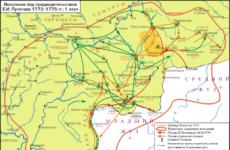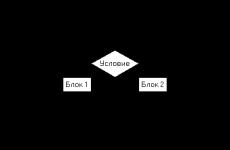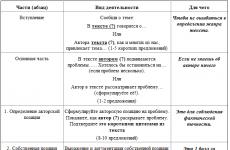§15. The rate of a chemical reaction. Goal: find out what the rate of a chemical reaction is and what factors it depends on. During the lesson we will get acquainted with the theory. What is called the rate of a chemical reaction in which
Speed reaction is determined by the number of elementary acts of interaction occurring per unit time in a unit volume (for homogeneous reactions) or per unit interface surface (for heterogeneous reactions). The rate of a reaction is usually characterized by changes in the concentration of reactants over time. Concentration in solution is expressed in mol/l, in gases - partial pressure, time in seconds. The change in concentration DC=C 2 -C 1 over the period of time Dt=t 2 -t 1 will determine the speed of the process.
“-” sign when the concentration of reactants decreases, “+” sign when the concentration of reaction products increases.
The rate of a reaction can be judged by the rate of change of any property of the system, for example, color, electrical conductivity, spectrum, pressure, precipitation, gas evolution, etc.
The speed of the process is proportional to the probability of particle collision, which is determined by their concentration.
This pattern was established experimentally in 1864-67 by K. Guldberg and P. Waage, in 1865 by N.I. Beketov, is the basic law of chemical kinetics and is called law of mass action: at a constant temperature, the rate of homogeneous chemical reactions is directly proportional to the product of the concentrations of the reacting substances raised to the power of their stoichiometric coefficients.
So for reactions
1) H 2 +Cl 2 =2HCl,  ;
;
2) 2NO+O 2 =2NO 2,  .
.
k – coefficient of proportionality or rate constant, shows what part of the total concentration of substances reacts under given conditions, is determined by the nature of the substances and changes with temperature.
The value of k is numerically equal to the reaction rate when the concentrations of the reactants are equal to unity.
The movements are all a continuous chain
form and arise one of
another in a certain order.
Lucretius
What is the mechanism of a chemical reaction? What is the kinetic equation of a reaction and what is its meaning? What is the mechanism of action of the catalyst? What are inhibitors?
Lesson-lecture
CHEMICAL REACTION AS AN EXAMPLE OF MOTION. Remember what the rate of a chemical reaction is and what factors it depends on.
Chemical reactions occur at different rates. The range of their speeds is extremely wide - from almost instantaneous reactions (explosion, many reactions in solutions) to extremely slow ones, taking centuries (for example, oxidation of bronze in air).
Engraving. Alchemists
In the 19th century it was found that chemical reactions in the overwhelming majority are multistage processes, i.e., they are not accomplished through direct simultaneous collisions of reagent particles with the formation of products, but through a series of simple (elementary) processes. Indeed, if, for example, the oxidation reaction of ammonia proceeded in one stage, it would require enormous energy expenditure for the simultaneous breaking of bonds in the ammonia and oxygen molecules. In addition, the probability of a collision between three particles is very small, and that of four particles is practically zero. The simultaneous collision of seven particles (four molecules of ammonia and three molecules of oxygen) is simply impossible.
Each elementary stage of a chemical reaction is either a chemical process (say, the disintegration of one molecule or a collision of two particles) or a transition of a particle to an excited state (or, conversely, its transition from an excited to a ground or low-excited state).
Even a seemingly simple reaction
goes through stages, and each stage proceeds at its own speed.
1st stage (fast):
![]()
Stage 2 (relatively slow):
Remember what particles are called radicals. What reactions are called chain reactions and what is activation energy?
The set of elementary stages of a chemical reaction, following one after another (i.e. sequentially) or occurring in parallel, is called mechanism chemical reaction. The reaction mechanisms are different.
It is very important for a chemist to know on what factors the rate of a chemical reaction depends. Particularly important is the dependence of the reaction rate (or its stages) on the concentrations of the reactants. This dependence is called kinetic equation. For a hypothetical reaction aA + bB = dD + eE, the mathematical expression (kinetic equation) has the form
![]()
where V is the rate of the chemical reaction; c is the concentration of the substance, mol/l; a, b are exponents (these values are determined experimentally). The coefficient of proportionality k in the kinetic equation is called rate constant chemical reaction. It is numerically equal to the rate of a chemical reaction at concentrations of reactants equal to 1 mol/l.
The rate of the elementary stages of the reaction is proportional to the product of the concentrations of the reactant particles, for example:
The rate of the overall reaction can depend in various, sometimes very complex ways on the concentration of the reagents.
Thus, the transformation of some substances into others is not a one-time event, but a process that unfolds over time, that is, it has its own time structure, which is expressed by the reaction mechanism. At the same time, the reaction mechanism takes into account not only changes in the composition of the substances participating in the reaction, but also changes in the positions of atoms in space as the reaction proceeds. Therefore, we can talk about the spatiotemporal structure of the reaction.
The development of chemical kinetics, a field of chemistry that studies the rates and mechanisms of chemical reactions, began in the second half of the 19th century. The foundation of this discipline was laid in the 1880s. Dutch physical chemist Jacob van't Hoff and Swedish scientist Svante Arrhenius.
CATALYSIS. It has long been noted that some substances are capable of significantly increasing the rate of a chemical reaction, although they themselves do not change their chemical composition. Such substances are called catalysts. For example, hydrogen peroxide decomposes slowly at room temperature: 2H 2 0 2 = 2H 2 0 + 0 2. In the presence of platinum, the rate of its decomposition increases by more than 2000 times, and the enzyme catalase (contained in the blood) increases the reaction rate by 90 billion times!
The catalyst is not consumed in the chemical process. It is included in the intermediate stages of the process and regenerates at the very end. Therefore, the reaction equation itself does not include it.
The world of catalysts is wide and varied, as are their methods of action. But in general, we can say that a catalyst, when included in the reaction mechanism, changes it and directs the process along an energetically more favorable path. Moreover, what is especially important is that catalysts can cause processes to occur at a noticeable speed that would practically not occur without them.
Each catalyst can accelerate only certain types of reactions, and in some cases only certain reactions. This feature of catalysts is called selectivity. The selectivity of the action of catalysts makes it possible to obtain only a certain desired product in a certain way: to “direct” the action of a drug, etc. Biological catalysts are distinguished by the greatest selectivity and efficiency - enzymes, which catalyze biochemical reactions occurring in living organisms.
There are substances that slow down or even stop chemical processes. They are called inhibitors. However, unlike catalysts, inhibitors are consumed during the reaction.
- What factors determine the rates of chemical reactions?
- Can the rate of any reaction be proportional to the square of the concentration of a substance? If yes, please provide examples.
- Propose a hypothesis to explain why, unlike catalysts, inhibitors are consumed during the reaction.
Some chemical reactions occur almost instantly (explosion of an oxygen-hydrogen mixture, ion exchange reactions in an aqueous solution), others quickly (combustion of substances, interaction of zinc with acid), and others slowly (rusting of iron, rotting of organic residues). Reactions are known to be so slow that a person simply cannot notice them. For example, the transformation of granite into sand and clay occurs over thousands of years.
In other words, chemical reactions can occur with different speed.
But what is it speed reaction? What is the exact definition of this quantity and, most importantly, its mathematical expression?
The rate of a reaction is the change in the amount of a substance per unit of time in one unit of volume. Mathematically, this expression is written as:
Where n 1 Andn 2 – amount of substance (mol) at time t 1 and t 2, respectively, in a system of volume V.
What plus or minus sign (±) will appear in front of the speed expression depends on whether we are looking at a change in the amount of a substance - a product or a reactant.
Obviously, during the reaction, reagents are consumed, that is, their quantity decreases, therefore, for reagents, the expression (n 2 - n 1) always has a value less than zero. Since speed cannot be a negative value, in this case you need to put a minus sign in front of the expression.
If we look at the change in the amount of the product, and not the reactant, then the minus sign is not required before the expression for calculating the speed, since the expression (n 2 - n 1) in this case is always positive, because the amount of product as a result of the reaction can only increase.
Substance quantity ratio n to the volume in which this amount of substance is located is called molar concentration WITH:
Thus, using the concept of molar concentration and its mathematical expression, we can write another option for determining the reaction rate:
The reaction rate is the change in the molar concentration of a substance as a result of a chemical reaction in one unit of time:
Factors affecting reaction speed
It is often extremely important to know what determines the speed of a particular reaction and how to influence it. For example, the oil refining industry literally fights for every additional half a percent of product per unit of time. After all, given the huge amount of oil processed, even half a percent results in a large financial annual profit. In some cases, it is extremely important to slow down some reaction, in particular the corrosion of metals.
So what does the reaction rate depend on? It depends, oddly enough, on many different parameters.
In order to understand this issue, first of all, let's imagine what happens as a result of a chemical reaction, for example:
A + B → C + D
The equation written above reflects the process in which molecules of substances A and B, colliding with each other, form molecules of substances C and D.
That is, undoubtedly, in order for the reaction to take place, at a minimum, a collision of the molecules of the starting substances is necessary. Obviously, if we increase the number of molecules per unit volume, the number of collisions will increase in the same way that the frequency of your collisions with passengers on a crowded bus will increase compared to a half-empty one.
In other words, the reaction rate increases with increasing concentration of reactants.
In the case where one or more of the reactants are gases, the reaction rate increases with increasing pressure, since the pressure of a gas is always directly proportional to the concentration of its constituent molecules.
However, the collision of particles is a necessary, but not at all sufficient condition for the reaction to occur. The fact is that, according to calculations, the number of collisions of molecules of reacting substances at their reasonable concentration is so great that all reactions must occur in an instant. However, in practice this does not happen. What's the matter?
The fact is that not every collision of reactant molecules will necessarily be effective. Many collisions are elastic—the molecules bounce off each other like balls. In order for a reaction to take place, the molecules must have sufficient kinetic energy. The minimum energy that the molecules of the reacting substances must have in order for the reaction to take place is called the activation energy and is denoted as E a. In a system consisting of a large number of molecules, there is a distribution of molecules by energy, some of them have low energy, some have high and medium energy. Of all these molecules, only a small fraction of the molecules have an energy greater than the activation energy.
As you know from a physics course, temperature is actually a measure of the kinetic energy of the particles that make up a substance. That is, the faster the particles that make up a substance move, the higher its temperature. Thus, obviously, by increasing the temperature we essentially increase the kinetic energy of molecules, as a result of which the proportion of molecules with energy exceeding E a increases and their collision will lead to a chemical reaction.
The fact of the positive effect of temperature on the rate of reaction was empirically established by the Dutch chemist Van't Hoff back in the 19th century. Based on his research, he formulated a rule that still bears his name, and it goes like this:
The speed of any chemical reaction increases 2-4 times with an increase in temperature by 10 degrees.
The mathematical representation of this rule is written as:
Where V 2 And V 1 is the speed at temperatures t 2 and t 1, respectively, and γ is the temperature coefficient of the reaction, the value of which most often lies in the range from 2 to 4.
Often the speed of many reactions can be increased using catalysts.
Catalysts are substances that speed up the course of a reaction without being consumed.
But how do catalysts increase the rate of a reaction?
Let's remember about the activation energy E a. Molecules with an energy lower than the activation energy in the absence of a catalyst cannot interact with each other. Catalysts change the path along which a reaction proceeds, just as an experienced guide will route an expedition not directly through a mountain, but with the help of detour paths, as a result of which even those companions who did not have enough energy to climb a mountain will be able to move to another her side.
Despite the fact that the catalyst is not consumed during the reaction, it nevertheless takes an active part in it, forming intermediate compounds with the reagents, but by the end of the reaction it returns to its original state.
In addition to the above factors affecting the reaction rate, if there is an interface between the reacting substances (heterogeneous reaction), the reaction rate will also depend on the contact area of the reactants. For example, imagine a granule of aluminum metal that is dropped into a test tube containing an aqueous solution of hydrochloric acid. Aluminum is an active metal that can react with non-oxidizing acids. With hydrochloric acid, the reaction equation is as follows:
2Al + 6HCl → 2AlCl 3 + 3H 2
Aluminum is a solid, which means that the reaction with hydrochloric acid occurs only on its surface. Obviously, if we increase the surface area by first rolling the aluminum granule into foil, we thereby provide a larger number of aluminum atoms available for reaction with the acid. As a result, the reaction rate will increase. Similarly, increasing the surface area of a solid can be achieved by grinding it into powder.
Also, the rate of a heterogeneous reaction in which a solid reacts with a gaseous or liquid substance is often positively influenced by stirring, which is due to the fact that as a result of stirring, the accumulated molecules of reaction products are removed from the reaction zone and a new portion of reactant molecules is “brought in.”
Lastly, it should also be noted the enormous influence on the rate of reaction and the nature of the reagents. For example, the lower an alkali metal is in the periodic table, the faster it reacts with water, fluorine, among all halogens, reacts most quickly with hydrogen gas, etc.
Summarizing all of the above, the speed of the reaction depends on the following factors:
1) concentration of reagents: the higher, the greater the reaction rate
2) temperature: with increasing temperature, the rate of any reaction increases
3) contact area of the reactants: the larger the contact area of the reagents, the higher the reaction rate
4) stirring, if a reaction occurs between a solid and a liquid or gas, stirring can speed it up.






